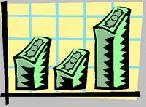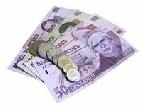
 |
|
| Financial Terms | |
| Dow Jones Industrial Average |
|
Information about financial, finance, business, accounting, payroll, inventory, investment, money, inventory control, stock trading, financial advisor, tax advisor, credit.
Main Page: inventory control, inventory, finance, accounting, payroll, credit, business, investment, |
Definition of Dow Jones Industrial Average
Dow Jones Industrial AverageIndex of the investment performance of a portfolio of 30 ÔÇťblue-chipÔÇŁ stocks. Dow Jones industrial averageThis is the best known U.S.index of stocks. It contains 30 stocks that trade on
Related Terms:AverageAn arithmetic mean of selected stocks intended to represent the behavior of the market or some Arithmetic average (mean) rate of returnArithmetic mean return. Average accounting returnThe average project earnings after taxes and depreciation divided by the average Average age of accounts receivableThe weighted-average age of all of the firm's outstanding invoices. Average collection period, or days' receivablesThe ratio of accounts receivables to sales, or the total Average cost of capitalA firm's required payout to the bondholders and to the stockholders expressed as a  Average lifeAlso referred to as the weighted-average life (WAL). The average number of years that each Average maturityThe average time to maturity of securities held by a mutual fund. Changes in interest rates Average (across-day) measuresAn estimation of price that uses the average or representative price of a Average rate of return (ARR)The ratio of the average cash inflow to the amount invested. Average tax rateTaxes as a fraction of income; total taxes divided by total taxable income. Builder buydown loanA mortgage loan on newly developed property that the builder subsidizes during the BuydownsMortgages in which monthly payments consist of principal and interest, with portions of these CramdownThe ability of the bankruptcy court to confirm a plan of reorganization over the objections of Discount windowFacility provided by the Fed enabling member banks to borrow reserves against collateral  Down-and-in optionBarrier option that comes into existence if asset price hits a barrier. Down-and-out optionBarrier option that expires if asset price hits a barrier. DowngradeA classic negative change in ratings for a stock, and or other rated security. Endowment fundsInvestment funds established for the support of institutions such as colleges, private Industrial revenue bond (IRB)Bond issued by local government agencies on behalf of corporations. Moving averageUsed in charts and technical analysis, the average of security or commodity prices PaydownIn a Treasury refunding, the amount by which the par value of the securities maturing exceeds that Simple moving averageThe mean, calculated at any time over a past period of fixed length. Top-down equity management styleA management style that begins with an assessment of the overall Weighted average cost of capitalExpected return on a portfolio of all the firm's securities. Used as a hurdle Weighted average couponThe weighted average of the gross interest rate of the mortgages underlying the  Weighted average lifeSee:average life. Weighted average maturityThe WAM of a MBS is the weighted average of the remaining terms to maturity Weighted average remaining maturityThe average remaining term of the mortgages underlying a MBS. Weighted average portfolio yieldThe weighted average of the yield of all the bonds in a portfolio. Window contractA guaranteed investment contract purchased with deposits over some future designated Write-downDecreasing the book value of an asset if its book value is overstated compared to current market values. WEIGHTED AVERAGEAn inventory valuation method that calculates a weighted average cost per unit for all the goods available for sale. Weighted average cost of capitalSee cost of capital. Weighted averageA method of accounting for inventory. inventory write-downRefers to making an entry, usually at the close of a weighted-average cost of capitalWeighted means that the proportions of Average Collection Periodaverage number of days necessary to receive cash for the sale of Weighted Average Cost of Capital (WACC)The weighted average of the costs of the capital components downsizingany management action that reduces employment weighted average cost of capitala composite of the cost of the various sources of funds that comprise a firmÔÇÖs capital structure; the minimum rate of return that must be earned on new investments so as not to dilute shareholder value weighted average method (of process costing)the method of cost assignment that computes an average cost per Moving averageA price average that is adjusted by adding other Moving-averages chartA financial chart that plots leading and lagging Average inventoryThe beginning inventory for a period, plus the amount at the end of Moving average inventory methodAn inventory costing methodology that calls for the re-calculation of the average cost of all parts in stock after every purchase. average tax rateTotal taxes owed divided by total income. weighted-average cost of capital (WACC)Expected rate of return on a portfolio of all the firmÔÇÖs securities, adjusted for tax savings due to interest payments. Average Propensity to ConsumeRatio of consumption to disposable income. See also marginal propensity to consume. Average Propensity to SaveRatio of saving to disposable income. See also marginal propensity to save. Discount WindowThe Federal Reserve facility at which reserves are loaned to banks at the discount rate. Average-Cost Inventory MethodThe inventory cost-flow assumption that assigns the average Average Amortization PeriodThe average useful life of a company's collective amortizable asset base. Write-DownA reduction in the balance-sheet valuation of an asset with an accompanying EndowmentLife insurance payable to the policyholder, if living on the maturity date stated in the policy, or to a beneficiary if the insured dies before that date. For example, some Term to age 100 policies offer the option of taking the face amount of the policy as a cash payout at age 100 if the policyholder is still alive and paying all required income taxes on the amount received or leaving the policy to pay out upon death whereupon the payout is tax free. Weighted Average Cost of Capital (WACC)A weighted average of the component costs of debt, preferred shares, and common equity. Also called the composite cost of capital. Related to : financial, finance, business, accounting, payroll, inventory, investment, money, inventory control, stock trading, financial advisor, tax advisor, credit. |